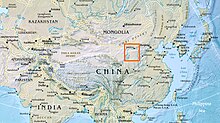
Back حضارة أوردوس Arabic Дагістарычны Ордас Byelorussian Ordos (cultura) Catalan Ordos-Kultur German Cultura ordos Spanish فرهنگ اردوس Persian Ordoksen kulttuuri Finnish Culture de l'Ordos French オルドス青銅器文化 Japanese 오르도스 문화 Korean
 | |
| Geographical range | Ordos Plateau |
|---|---|
| Period | late Neolithic to early Bronze Age |
| Dates | c. 800–150 BCE[1] |
| Preceded by | Zhukaigou culture Shimao culture Siwa culture Xicha culture |
| Followed by | Han dynasty |

The Ordos culture (simplified Chinese: 鄂尔多斯文化; traditional Chinese: 鄂爾多斯文化) was a material culture occupying a region centered on the Ordos Loop (corresponding to the region of Suiyuan, including Baotou to the north, all located in modern Inner Mongolia, China)[3] during the Bronze and early Iron Age from c. 800 BCE to 150 BCE.[4] The Ordos culture is known for significant finds of Scythian art and may represent the easternmost extension of Indo-European Eurasian nomads, such as the Saka,[5][6][7] or may be linkable to Palaeo-Siberians or Yeniseians.[8] Under the Qin and Han dynasties, the area came under the control of contemporaneous Chinese states.
- ^ Honeychurch, William (2015). Inner Asia and the Spatial Politics of Empire: Archaeology, Mobility, and Culture Contact (PDF). p. 112. doi:10.1007/978-1-4939-1815-7. ISBN 978-1-4939-1814-0.
- ^ Maenchen-Helfen, Otto; Helfen, Otto (1 January 1973). The World of the Huns: Studies in Their History and Culture. University of California Press. p. 371. ISBN 978-0-520-01596-8.
- ^ The Silk Road Encyclopedia. Seoul Selection. 18 July 2016. p. 1959. ISBN 978-1-62412-076-3.
- ^ Honeychurch, William (2015). Inner Asia and the Spatial Politics of Empire: Archaeology, Mobility, and Culture Contact (PDF). p. 112. doi:10.1007/978-1-4939-1815-7. ISBN 978-1-4939-1814-0.
- ^ Lebedynsky 2007, p. 131
- ^ Macmillan Education 2016, p. 369 "From that time until the HAN dynasty the Ordos steppe was the home of semi-nomadic Indo-European peoples whose culture can be regarded as an eastern province of a vast Eurasian continuum of Scytho-Siberian cultures."
- ^ Harmatta 1992, p. 348: "From the first millennium b.c., we have abundant historical, archaeological and linguistic sources for the location of the territory inhabited by the Iranian peoples. In this period the territory of the northern Iranians, they being equestrian nomads, extended over the whole zone of the steppes and the wooded steppes and even the semi-deserts from the Great Hungarian Plain to the Ordos in northern China."
- ^ "The genetic and linguistic evidence for the xiongnu-yenisseian hypothesis". ResearchGate. Retrieved 1 February 2022.